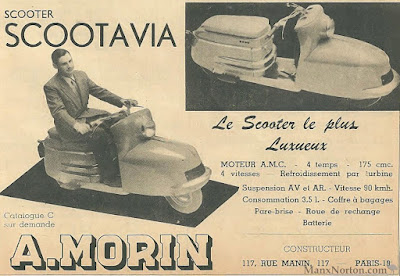At the end of the 1940s, which was spearheaded by the appearance of a series of Vespa (Piaggio) and Lambretta (Innocenti) products which became known as the most revolutionary two-wheeled vehicle figures in the world. Piaggio and Innocenti through their scooter creations that are strong, tough, comfortable to drive and have an affordable price tag.
 |
| The 1st Yamaha scooter product launched in 1960 and named Yamaha SC-1. (Picture from: http://bit.ly/2pTfMUm) |
And in its development then managed to make the scooter to develop in such a way that it became a figure of two-wheeled vehicles whose existence at that time was even able to change the face of the automotive world and shake the existence of motorbikes in general.
 No exception in Japan, which later also to follow the trend of scooters in the 1950s through several pioneering manufacturers such as Mitsubishi with the Silver Pigeon, then there was Fuji Heavy Industries with the Rabbit turned out to also feel the sweetness of success in the market of two-wheeled vehicles, especially scooters. Whether it's recognized or not, this also seems to inspire other Japanese manufacturers such as Yamaha Motor Company to join into the scooter segment.
No exception in Japan, which later also to follow the trend of scooters in the 1950s through several pioneering manufacturers such as Mitsubishi with the Silver Pigeon, then there was Fuji Heavy Industries with the Rabbit turned out to also feel the sweetness of success in the market of two-wheeled vehicles, especially scooters. Whether it's recognized or not, this also seems to inspire other Japanese manufacturers such as Yamaha Motor Company to join into the scooter segment. |
| Front view of 1960 Yamaha SC-1 scooter. (Picture from: http://bit.ly/2XZSysx) |
At that time, Yamaha was just starting to be active in the world of the two-wheeled vehicle industry, after launching its first motorcycle product namely the Yamaha YA-1 in 1955 which was followed by a series of other models such as YD-1 & YDS-1 until 1959. And then in March 1960, the three-tuning forks-logoed motorcycle manufacturer then released a scooter product named Yamaha SC-1 and is believed to have the meaning of Yamaha Scooter 1 or the first scooter from Yamaha.
The Yamaha SC-1 is presented not as a 'trial and error' product, this can be seen with a variety of the latest technology at that time deliberately installed on this scooter by Yamaha. Then from the SC-1 scooter design, Yamaha tried to display slightly different designs and styles from the top Italian scooters such as Vespa, which at that time carried more rounded shape design with the headlight placement on the handlebar. While Yamaha presented a taper, boxier-shaped design pattern with the headlight placement on the front body (like most German and British scooter designs in the 1950s).
 |
| Right side view of 1960 Yamaha SC-1 scooter. (Picture from: http://bit.ly/2R0PmLo) |
Then the chassis has applied a strong and sturdy monocoque chassis system. For the suspension is somewhat special, by using the single-sided suspension model on the front and rear wheels. With such those suspension system applied certainly makes it easier for its users, especially when they replace the rear wheels.
The Yamaha SC-1 scooter produced only for the Japanese domestic market (JDM) has a size that is arguably small, with a length of 1,770 mm. However, it has fairly hefty ie around 123 kg, this is due to dominantly use of the metal materials on its monocoque chassis. Then other sophisticated features that were also installed on this scooter include the use of an electric starter with the help of a dynamo in the engine.
Meanwhile, for the engine, Yamaha equips its SC-1 scooter with an air-cooled 2-stroke single-cylinder 175 cc engine. And Yamaha claimed that the engine is capable of producing power of around 10.3 horsepower at 5,500 rpm and a maximum torque of 15 Nm at 3,600 rpm. Then all those power is channeled to the rear wheel through the shaft with 2-speed manual transmission systems.
Kept spur your adrenaline on the power of the two-wheeled monster and stay alive with true safety riding. May God will forgive Your sins and
so does the cops...... *** [EKA | FROM VARIOUS SOURCES | YAMAHA]
Note: This blog can be accessed via your smart phone.









































